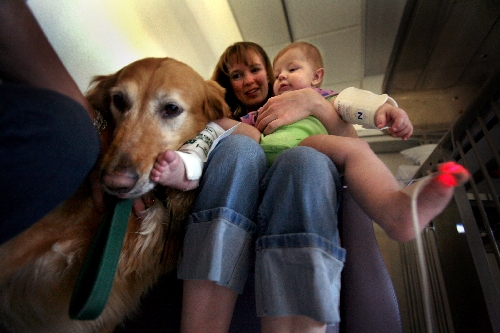Ailing youngsters respond to dog therapy

Juan Bablo watches Winnie the Pooh on the TV in his hospital room, holding his blue lightsaber, when he senses something.
He doesn’t know what it is, but it’s close. He can sense it, like Winnie the Pooh senses honey.
The 2-year-old slides off the chair and walks over to the doorway in his red “Cars” sneakers, peeking into the usually silent, sterile hallway of linoleum floors and medical equipment.
There sits Brit, a golden retriever, waiting, tail wagging shortly after passing through the double doors of pediatrics at University Medical Center.
Another boy is on his way too but in a toy car, urging it forward like Fred Flintstone, feet to the floor from the driver’s seat.
“Brit is something different that they don’t expect to see in a hospital. It’s something normal,” Cynthia Jones, manager of pediatrics intensive care, says as Brit walks over and sits next to Juan.
The dog, one of two currently volunteering at the hospital, gives sick children an incentive to rise out of their beds and move around, which helps recovery, Jones says. That’s the point of Brit’s weekly visits with owner Karen Andrew. But there’s much more to therapy dogs than to get children’s blood flowing.
“The touch is supposed to be the magic, the connection,” says Andrew, watching Juan kneel on the floor and stroke Brit’s paw. “They have an innate ability to get better.”
Brit will even go into intensive care units where children are on breathing machines, their eyes closed.
The child’s hand will be placed on Brit, and they’ll start petting, intrinsically knowing the feel of dog’s fur, Jones says.
“Go to work,” Jones tells Brit.
Like a nurse checking on patients, Brit makes her rounds, room by room.
Brit’s first stop is 9-year-old Juan Morales, wearing a yellow shirt down to his knees with the face of Spongebob Squarepants on the front.
He has been here for nine days because of a ruptured appendix and wants to go home, his mother says.
But, for now, he is fixated on the dog.
“It’s a much needed distraction, helps them to feel like they’re home,” says child-life specialist Catherine Coleman.
Doctors look past the shedded hair on the floor, realizing the benefit of Brit’s visits may be unmeasurable but quite real.
“Can that dog go in this room now?” doctors often ask Coleman for especially ill children.
And it’s a truly symbiotic relationship for Brit and Andrew.
“She and I are both cancer survivors, which is why we do this,” Andrew says.
Brit snuggles into the spoiling. The 7-year-old dog has had a rough life. She was found mauled in the desert near Pahrump, most of her fur ripped off.
Brit also participates in Reading to Rover, a program where she sits while children read for 20 minutes. Children who have trouble reading will open up to a dog, Andrew says.
The situation is similar at the hospital, where quiet children will at first reluctantly stroke Brit.
As a smile creeps across their faces, they’ll pull their fingers over Brit’s silky ears and eventually start talking to Andrew.
That was the case for Frank Rafter.
The 15-year-old, wearing a doctors mask over his mouth and nose while lying in bed, has been here for five days because of cystic fibrosis.
The chronic disease causes thick, sticky mucus to build up in his lungs.
Frank starts by extending his hand to Brit’s head beside her bed. But then she lies down.
Frank must sit up to reach her. Before long, he is on the floor with her, flapping her large ears like bird’s wings.
“Fly,” he says. “I love dogs, just not little ones.”
“We have two Chihuahuas at home,” Frank’s mother says.
“You’re coming with me,” he tells Brit as he stands up and wipes a layer of golden fur off his camouflage pajamas. “I don’t care about the fur.”
As Andrew and Brit are on their way out, another unusual sight enters the building downstairs.
Doctor Magic and his wife, Mrs. Magic, wheel a nurse’s cart through the doorway. They’re wearing doctors outfits with a twist.
Doctor Magic’s stethoscope is constructed from garden hoses with a sprinkler at the end, another smile-evoking reminder of home and summer.
He reaches into the cart and grabs one of the quarter-sized, smiley-face sponges he gives to children.
“Take this so you’ll have a smile with you wherever you go,” he tells them.
Contact reporter Trevon Milliard at
tmilliard@reviewjournal.com or 702-383-0279.